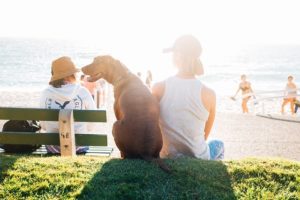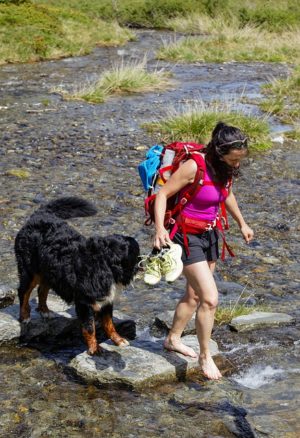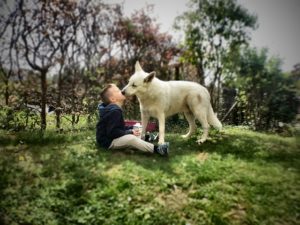 EASY TIPS TO PROTECT YOUR DOG
EASY TIPS TO PROTECT YOUR DOG
Hello everyone and welcome back to the Blog. During the hot summer months, we often discuss skin cancer and the ways we can protect ourselves. We need to remember, however, that we’re not the only ones at risk while having fun in the sun. Our sweet dogs can also develop skin cancer. So, let’s spend a little time today focusing on Fido’s needs, and the ways we can protect our canine companions from this all-too-common disease.
Interestingly, skin cancer in dogs is surprisingly similar to skin cancer in humans. There are certain risk factors that determine our dog’s susceptibility to this disease, and here are five of the most important.
SUN EXPOSURE
Just like we humans, UVA and UVB rays are harmful and can cause damage to sensitive skin, even if most of that skin is covered in fur.
SKIN INFLAMMATION AND LESIONS
In my first book, The Single Source Cancer Course, I discuss The Cancer Blueprint, which refers to skin that has been damaged. When skin becomes damaged and cells have been injured from constant irritation, or numerous cuts and scrapes, those cells become weakened. And when this occurs, these same cells become more susceptible to illness and disease, including cancer.
HEREDITY
Some breeds are more likely to develop skin cancers than others. For example, dogs with black coats appear to develop more melanomas on the paws and in the nail beds. Dogs with thin, short and light-colored coats are more likely to develop squamous cell carcinomas on their sensitive skin.
FEMALE HORMONES
Just as estrogen and progesterone are linked to the development of skin cancer in humans, these female hormones also are linked to the development of skin cancer in our canine four-legged girls.
PAPILLOMA VIRUS
Similar to the Human Papilloma Virus, this canine virus can wreck just as much havoc with our pups as it can with us. It causes small warts and sores around the mouth that can lead to squamous cell cancers.
Of course, the most vulnerable doggie body parts are those that are covered in less fur and are more exposed to the elements, such as the nail beds and paw pads, the mouth and muzzle, the nose and ears, and the abdomen.
And now that we understand some of the risks associated with canine skin cancer, here are some tips for protecting every Fido and Rover.
 STOP EXCESSIVE LICKING
STOP EXCESSIVE LICKING
This may contribute to the development of cancer-related mutations. Licking may indicate the presence of a skin inflammation, lesion or infection, which can damage the skin and leave it more vulnerable to possible skin cancers.
TALK TO YOUR VET
Make sure you understand the hereditary cancer risks your dog may face based on breed and coloring.
AVOID DOGS THAT APPEAR TO BE SICK
The best way to treat a virus or illness is to avoid it in the first place. Be especially careful when visiting your vet. Remember that dogs in the vet’s waiting room are there for a reason. Don’t allow your dog to socialize during doctor visits with other four-legged patients.
HAVE REGULAR CHECK-UPS
Make sure you schedule an annual exam for your pup replete with a full-body inspection. And always visit your vet if you notice any lump, bump, sore or discoloration on your pup’s skin.
PRACTICE SUN SENSE
Remember, sun sense is really just common sense. Don’t expose your pup to the hottest hours of the day and the strongest rays of the sun. Always provide a shady area for rest outdoors. And, be careful of piping hot surfaces like asphalt, sand and concrete that can burn and damage delicate paws.
Moreover, if your pooch is an athlete that spends a lot of time swimming at the beach or hiking in the mountains, consider these great options:
SUN BLOCK CLOTHING
Try some protective gear like vests and hats. These products not only block the sun’s harmful ultraviolet rays but often are infused with SPF protection as well.
DOGGY SUN SCREEN
Yep. It’s specially made for the canine in your life. Just apply to the vulnerable areas we discussed like the nose, ears, eye area and paws.
DOGGY SUN GLASSES OR GOGGLES
Affectionately known as DOGGLES, these protective eye gear come in a variety of sizes and styles, all designed to please the most discerning dog divas. They offer great protection for sensitive eyes from sun, spray and wind.
 And there we have the low-down on canine skin cancer. Just as we protect our own health, we can protect the health of our pets by obtaining information and exercising a little common sense. Doing so will help insure years of togetherness for you and your best friend.
And there we have the low-down on canine skin cancer. Just as we protect our own health, we can protect the health of our pets by obtaining information and exercising a little common sense. Doing so will help insure years of togetherness for you and your best friend.
Once again thanks for joining me everyone and enjoy a wonderful and safe summer. Until next time, stay in GOOD HEALTH and . . .
TAKE THE COURSE AND TAKE CHARGE!



Leave a Comment